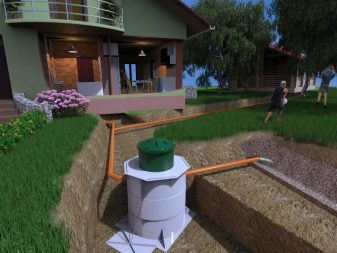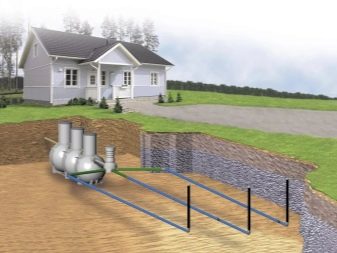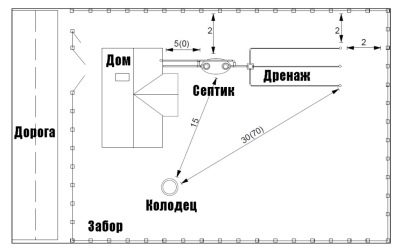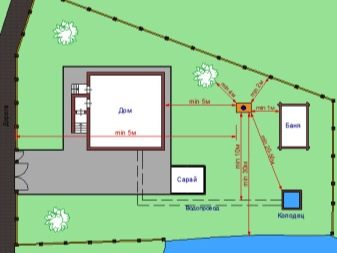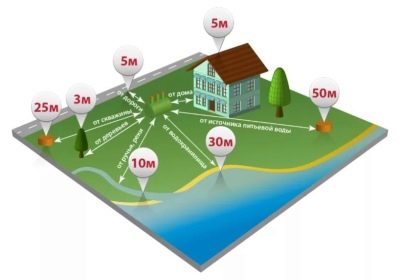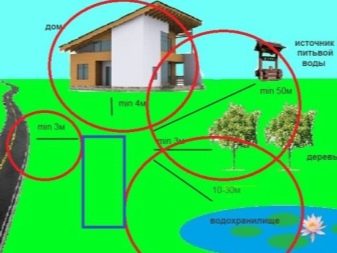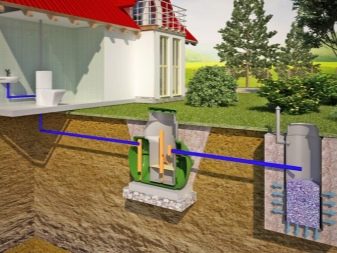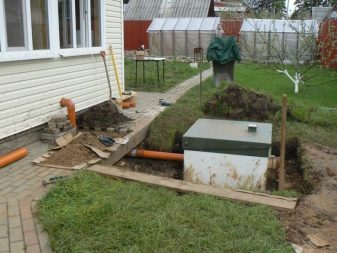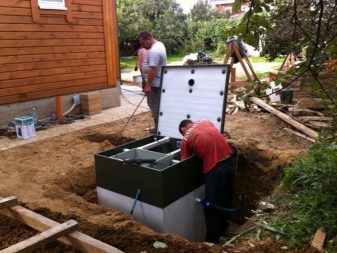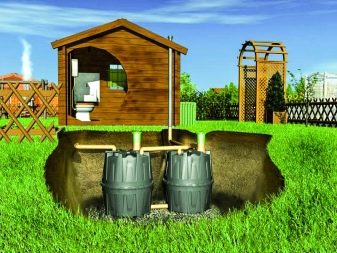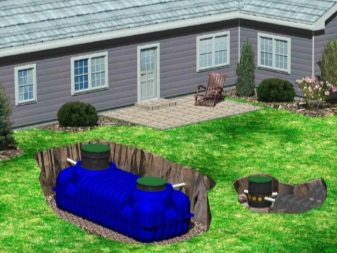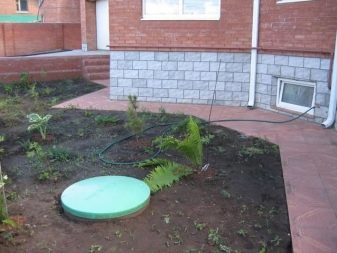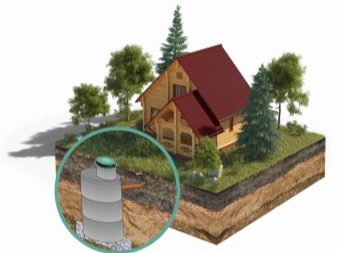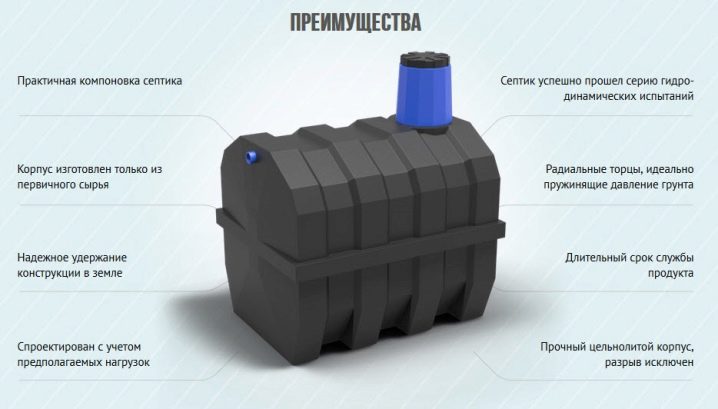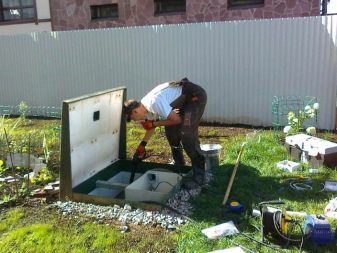How to determine the distance from the septic tank to the house?
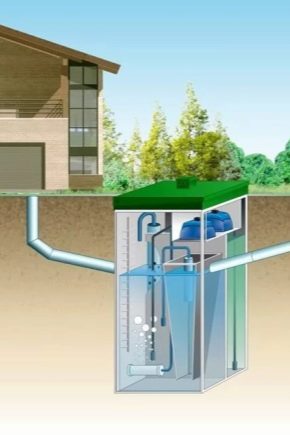
The septic tank is an integral part of the sewage system of a private house, so the choice of its location on the site should be taken seriously. Obviously, the odor from the aeration zones and sedimentation tanks is not the most fragrant, and the moisture that is filtered into the soil creates high humidity, and placing septic tanks near residential buildings and water intake sources can be not only unpleasant, but also dangerous to health.
Proper placement
The construction of a septic tank is considered the most practical option for arranging sewage systems in country houses and country houses, howeverso far in many large cities there are areas, especially designed for cottage development, where there is no urban drainage, so there is also a need for the construction of a sump.
It will be correct if the selection of a site for the sewage treatment plant will be carried out at the design stage of the land plot. Only in this case will it be possible to competently find a space so that it meets all existing sanitary standards.
Let's say more, before installing a septic tank, it is necessary to coordinate the project of its arrangement in the SES, otherwise the building will be declared an illegal construction and may result in numerous troubles for its owner.
At best, you will get off with just a fine, and at worst you will be forced to dismantle the entire structure - this will result in not only tremendous financial expenses, but also significant discomfort for all family members.
In order to avoid these problems, it is extremely important to know all the basic rules for safe arrangement of cesspools. These rules are governed by the current SNiP 2.04.02-84, 2.04.02-85, as well as 2.04.03-85 and 2.1.5.980-000.It is these documents that establish the basic standards for building local sewage.
To residential building
If a septic tank is located in the immediate vicinity of a residential building, numerous unpleasant odors will annoy its inhabitants, which is why most homeowners and developers try to choose the place farthest from the premises, while taking into account the relief - if the area is uneven and hilly, then the septic tank is arranged in low spot.
Sanitary standard establishes that the minimum distance between the septic tank and a private house should be 5 metersonly in this case, households will be protected from the "amber" coming from the sewer. Approximately at such a distance there should be a filter well, if, of course, it is planned in the drainage and drainage system, since the water leaving it can flush the foundation of the structure and destroy it. As for cesspools themselves, they can be located even closer, but you should not risk your comfort by digging it directly under the windows.
Many owners of the site are trying to "push" the septic tank as far as possible at a distance of 15 meters or more.But this approach can not be called correct, because sewer pipes, which are longer than 8 meters, often have blockages that have to be cleaned.
That is why the standard value of 5 meters is optimal from sanitary and technical points of view.
In some cases, the arrangement of a septic tank at a close distance is allowed, but this is only possible with the installation of a high-quality wastewater treatment system. In addition, the reduction of the distance is allowed if the septic tank is made of thick reinforced concrete, and a solid waterproofing system is installed between it and the house.
To neighbors
Problems with neighbors are not needed by anyone, so when arranging a septic tank, it is necessary to take into account their interests. The desire to move the cesspool to the maximum distance from the house is understandable, but if at this the pit is located “right under the nose” of the neighbors, then they are unlikely to be delighted with it.
In the case when building is conducted in parallel on all plots, as is the case when developing new lands, it makes sense to agree in advance on the location of septic tanks on all plots, this will significantly reduce the risk of conflict situations in the future.
If the drainage system is built in an already operated house, then it makes sense to follow the existing standards that establish the minimum allowable distance from the septic tank to the neighbor fence at 2 meters.
Up well
It is very important that the septic tank is located at a distance from the water intake site, since it is necessary to eliminate any chance of contaminated water entering the water supply system that carries drinking water into the house, otherwise the water will become unsafe for the life and health of adults and children.
According to SNiP, from the cesspool to the well should be located at least 30 metershowever, if the water intake site is located below the level of a septic tank, or the site consists of highly permeable soils, the distance should be increased to 50 meters.
To the well
Similar requirements are imposed in relation to the distance between the septic tank and the well. Of course, the construction of the septic tank itself precludes any threat of the ingress of sewage into the well, but the occurrence of emergency situations can never be ruled out. As a result of the depressurization of the seams or the “vigorous activity” of rodents, the probability of water entering the soil increases significantly, therefore it is necessary to maintain the distance between the drain section and the well, which must be at least 20 metersand if the soil contains sand or sandy loam, then at least 50 meters.
To the track
It is very important to build septic tanks at a sufficient distance from the road, the minimum distance between these objects should be 5 meters.
The reasons here are technical: on busy roads, a high level of vibration is constantly maintained, which causes the gradual destruction of the walls of the septic tank, which significantly increases the risk of cracks and depressurization of the structure.
SES also makes recommendations regarding the remoteness of the cesspool from the garden. According to the regulations, it should be equipped at a distance of at least 4 meters from fruit trees and vegetable plantations. This is due to the fact that excessive waterlogging leads to rotting of the roots and death of plants.
And, of course, it is important to remember that the allowable distance between the septic tank and the rivers, lakes and streams should be no less than 10 meters.
Is it possible to take out of the site?
Many homeowners believe that existing septic tank installation regulations only apply tothe distance between the sewers and the main buildings and structures, so you can place them outside of your site, if the required distance is maintained.
This is not entirely true, since, in addition to the regulations of the sanitary services, civil legislation applies to any buildings. According to the law, any septic tank is a private sewage treatment plant, and they can be erected only on their own land, otherwise this building will be illegal, and the actions of its owners will be interpreted as land squatting.
If the construction of a sump outside the site will be noticed, the consequences will be the most bleak:
- at any time you can get an order to eliminate the illegal construction, and you will have to dismantle it at your own expense;
- when registering property rights to the house and land, it will be necessary to register a septic tank, and if it is erected beyond the borders of its own plot, this possibility will be difficult;
- if the land is officially owned by the municipality, then at any time the authorities can dispose of the plot at their discretion, ignoring the fact that there is an unformed septic tank there.
Therefore, all necessary approvals and permits should be carried out not only within the framework of sanitary standards, but also in accordance with the provisions of the current legislation governing the ownership of houses, land plots and economic structures.
Main hazards
Consider why it is so important to comply with all established standards. To understand why you need to correctly choose the location of the septic tank on the land, you must start with the basics:
- a septic tank is a sewage plant in which household waste accumulates and stands, its cleaning capacity does not exceed 60%, therefore it is very important to make the harm caused to the environment minimal;
- Most of the structures installed in private homes can in no way be considered full-fledged filters - they do not purify drains by more than 60%, and therefore should strive to minimize the damage caused by sewage waste to the soil and groundwater.
Of course, filters installed at industrial and municipal water intakes have an efficiency of about 99%, but they are quite expensive, so most of our compatriots cannot afford such designs.
All this leads to the fact that the installation of a septic tank creates certain environmental risks:
- due to the low tightness of the containers and their joints with pipes, waste may enter the soil;
- if the septic tank is located in the immediate vicinity of the aquifers, the drainage water can penetrate into the groundwater;
- during spring floods or in the absence of timely pumping of the tank, they may overflow, and sewage waste will be transferred to the site adjacent to the house;
- in case of violation of the integrity of the tanks, there may be a flooding of the foundation and the destruction of the supporting supports of a residential building.
To avoid these unpleasant problems, it is important to take very seriously the choice of the location of the septic tank, with special attention should be paid to the depth of installation of the container and sealing the joints and seams.
Additional requirements
Unfortunately, not every land plot, especially for houses located within the city, boasts a large area, sometimes even 3 meters is not enough, not to mention the need to withstand a five-meter distance from the septic tank to the residential building. It happens that there is not enough space.
The inability to maintain the required distance between the water well and the cesspool is not a reason to reduce it, because this requirement is not taken "from the ceiling"it is based on the need to preserve human health. Therefore, if the required five meters are not, then it makes sense to think about a different variant of the drainage system.
One way to solve the shortage of land could be to install a drive. Such a septic tank is a large reservoir installed in the ground, waste materials accumulate in it, and as the container is filled, it should be emptied with a special sewage disposal equipment.
The advantages of this option are obvious:
- low cost;
- environmental Safety.
But without the drawbacks can not do. Minuses:
- constant high maintenance costs of the drive;
- the appearance of persistent, long-lasting unpleasant smell when pumping.
A more modern option is the installation of VOCs, which carry out a full cycle of cleaning liquid waste and does not require the installation of soil cleaning systems. However, the cost of local treatment facilities is very high.
When building a septic tank, try to locate it in such a way that it has free access and access, so it would be optimal to place it near the gate.
The system of arrangement of sewage in private houses and country farms requires the closest attention, since its competent construction is the key to safe and comfortable living for adults and children.
On the intricacies of installing a septic tank on the site, see below.
